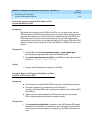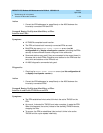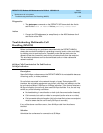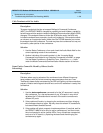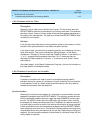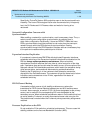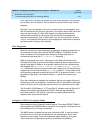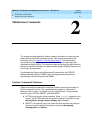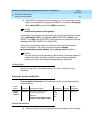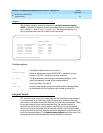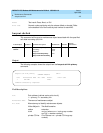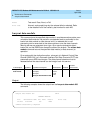
DEFINITY ECS Release 8.2 Maintenance for R8.2csi
555-233-119 Issue 1
April 2000
Maintenance for csi systems
1-141Troubleshooting Multimedia Call Handling (MMCH)
1
If the input from an endpoint is located too close to the speakers of an endpoint,
then acoustic echo is created. The microphone must be moved away from the
speakers.
Normally, if any microphone in the room is moved relative to the speakers, that
site will cause echo until the echo canceller in the codec retrains itself, some will
require a manual reset. If a PictureTel keypad is configured with external
microphones connected to the keypad, then the internal microphone and
external microphone(s) “sing” to each other if the “ext mic” bat switch is set to
“int mic” on the back of the keypad. In this configuration, VAS locked on that site,
and the acoustic “singing” was inaudible.
Rate Adaptation
Because of a lack of a clear explanation in standards, sometimes endpoints do
not work well with each other and the DEFINITY MMCH. The MMCH will only
allow a conference to downgrade from 64kbps to 56 kbps operation on
conferences that have the
Rate Adaptation
flag set to
y
.
When a downgrade does occur, information on the Status Conference form
indicates the success or failure of the 64kbps-endpoints that are participants to
properly rate adapt to 56kbps. As a general indication that the conference has
rate adapted, the
Conference Transfer Rate
and
Effective Transfer
Rate
fields show initial and current transfer rates, respectively. For each 64-kbps
endpoint the column that indicates
Rate Adapt
shows an
n
if the endpoint did
not follow the procedures as specified by the H.221. If an endpoint shows
y
, it did
successfully rate adapt. If an endpoint shows
c
, it joined the conference at
56kbps.
Once the conference rate adapts, the endpoints that do not properly follow suit,
will become audio-only endpoints. A conference will not rate adapt from 56 kbps
back to 64 kbps until all endpoints disconnect from the conference and it idles.
The PictureTel 1000 Release 1.1C, PictureTel 6.01 software, and the Vistium 2.0
software successfully rate adapt with the MCU. External rate adaptation
techniques used by VTEL and CLI are known to cause problems with the
endpoint when used with this feature.
Endpoint or I-MUX in Loopback Mode
Some endpoints have a loopback enable feature. This makes DEFINITY MMCH
data loopback at the MMCH when a connection is in progress. The loopback can
be enabled prior to or during a connection.
The MMCH does not detect the loop and continues to VAS. In most scenarios,
the switch occurs, but within a few seconds, the broadcaster’s return video
becomes its own image. Once the broadcaster stops speaking, the system
“false” switches to an apparently random port that was not speaking.



